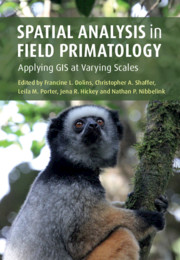Book contents
- Spatial Analysis in Field Primatology
- Spatial Analysis in Field Primatology
- Copyright page
- Dedication
- Contents
- Contributors
- Acknowledgments
- 1 Why Place Matters, and its Use in Primate Behavioral and Ecological Research
- Part I GPS for Primatologists
- Part II GIS Analysis in Fine-Scale Space
- Part III GIS Analysis in Broad-Scale Space
- Index
- Plate Section (PDF Only)
- References
1 - Why Place Matters, and its Use in Primate Behavioral and Ecological Research
Published online by Cambridge University Press: 29 January 2021
- Spatial Analysis in Field Primatology
- Spatial Analysis in Field Primatology
- Copyright page
- Dedication
- Contents
- Contributors
- Acknowledgments
- 1 Why Place Matters, and its Use in Primate Behavioral and Ecological Research
- Part I GPS for Primatologists
- Part II GIS Analysis in Fine-Scale Space
- Part III GIS Analysis in Broad-Scale Space
- Index
- Plate Section (PDF Only)
- References
Summary
Almost all behavior can be assessed spatially, paving the way for insights into both the proximate and ultimate causes of expressed behaviors. Field primatologists following their focal group or individual animal identify and record essential data about where salient behaviors occur because behaviors do not occur in random locations, but in relation to what the environment and habitat specifically affords to a primate with regard to traveling, foraging, defending a home range, finding mates, and fulfilling other basic and essential needs. Recording the “where” and also the “when” and the “what” of a traveling primate’s behavior in conjunction with the biogeography of the habitat is a multilayered, dynamic problem. The spatial analysis tools, global positioning systems (GPS), and geographic information systems (GIS) analysis provide a stable and powerful means to apply cutting-edge data and analytic methods to the study of free-ranging primate behavior. In this way, primatologists can address Tinbergen’s “Four Questions” of mechanism, ontogeny, adaptive value, and phylogeny underlying behaviors (Tinbergen 1963), and develop an overarching picture of their primate species’ patterns of behavior, habitat use, and life histories.
- Type
- Chapter
- Information
- Spatial Analysis in Field PrimatologyApplying GIS at Varying Scales, pp. 1 - 6Publisher: Cambridge University PressPrint publication year: 2021

